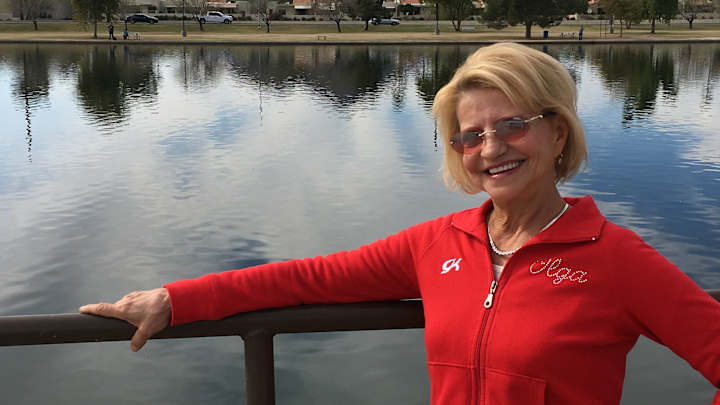Once soaring, Korbut staying grounded in the Arizona desert

SCOTTSDALE, Ariz. (AP) Olga Korbut walks around the man-made lake in anonymity, despite the bright red warmup jacket with ''Olga'' in sparkly letters on her left shoulder.
Korbut likes it here, this little suburban slice of nature, a place where she can get her body moving, listen to the birds, stroll alongside the dog walkers.
Korbut stops at a set of bars to stretch, torqueing her hip at an impossible-for-mortals angle that sends her right foot above her head. She moves to the other side of the bars, puts her hands on the ground and sends her feet into the air, propping them up against a sign. She holds the handstand for about 30 seconds and flips back over, waving her hands upward like a gymnast completing a routine.
Even at 61, Korbut is still strong and supple, appearing as if she could hop onto the uneven bars and complete the Korbut Flip, just as she did more than 40 years ago as a teenager who changed gymnastics forever.
So, too, is her mind, content with her place in history and her quiet life in Arizona.
''I love being here, with the nature, the nice weather,'' Korbut said, the accent from her native Belarus still noticeable. ''It's paradise.''
Korbut sprang onto the Olympic scene like a bottle rocket, a 4-foot-11, pigtailed waif who turned gymnastics on its head.
Nicknamed ''The Sparrow from Minsk,'' she did things no one had seen before, acrobatics that pushed the sport forward from balletic motions of the past. And she did it with an un-Soviet flair, playing up to crowd to the point it loved her even when she failed.
Korbut won three gold medals and a silver as a 17-year-old at the 1972 Munich Games, then added another gold and silver at Montreal in 1976.
She instantly became a worldwide star. People knew her around the world and treated her like royalty wherever she went, a transition that was sometimes difficult for a teenager from Grodno, near the borders with Poland and Lithuania.
''I came unknown to the Olympic Games and overnight people make me famous,'' Korbut said. ''I wasn't prepared for that, but it was funny when I came to the store with my money, they would give it to me free.''
Korbut traveled the world doing exhibitions and became an ambassador of sorts for her sport, once meeting President Richard Nixon. She spearheaded efforts to help victims of the 1986 Chernobyl accident and moved to the United States in 1991, becoming a gymnastics teacher and motivational speaker while continuing to raise money for victims of the nuclear accident.
Korbut struggled while coaching young gymnasts at first. Many of them lacked the motivation she had, but then again, few people have that kind of inner drive to be the best in the world.
Through the years, Korbut adjusted her coaching style and shifted to private classes, where the gymnasts tended to be more motivated.
''In the first, I saw that maybe they didn't want to do it, maybe their parents pushed them in it,'' she said. ''But I do my classes very differently, to not push them, but invite them into this world. I would show them my medals and tell them that it's not very hard if you love to do that. I show them and teach them to be in love with gymnastics.''
Korbut moved to Arizona after participating in a clinic here. She has spent her time in the desert giving private lessons and touring the world to promote gymnastics.
With her on every trip: her Olympic medals.
Korbut brings the medals with her everywhere, pulling them out at each stop so her fans can not only see but touch them.
''Millions of people around the world touched those medals through the years,'' said Jay Schanfeldt, Korbut's fiance.
Now her fans will have an opportunity to own those medals.
From Feb. 25-26, five of Korbut's Olympic medals - her floor exercise gold from Munich among them - and some of her Olympic memorabilia will be available at Heritage Auctions' Sports Platinum Auction.
Korbut and Schanfeldt say the selling of her memorabilia is not a desperate money grab, though they acknowledge the money certainly will be nice. They see it as more of a chance to make a deeper connection with her fans, allowing them to be part of a history they helped create.
''This is Olympic history and I would like to share with the whole world,'' Korbut said. ''They helped to make it history and make it live forever. This is how I wanted to share with the people.''
Once the auction is over, Korbut will go back to her peaceful life.
She'll continue to walk around the lake in the middle of Scottsdale every day, continue her workouts to stay in shape and teach the occasional private lesson if someone should want one from one of the greatest Olympics gymnasts of all time.
''Arizona is a retirement place, so I enjoy it here,'' she said. ''I always wanted to plant to garden. I never had time for that and now I will do whatever I want, plant fruits, herbs and enjoy the weather.''
